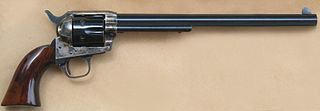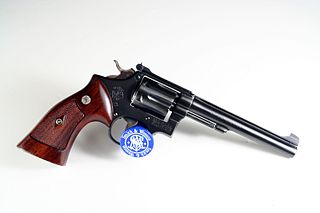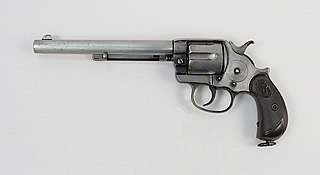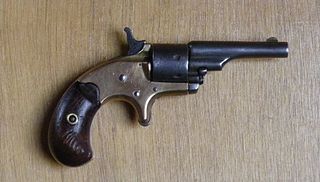
A revolver is a repeating handgun that has at least one barrel and uses a revolving cylinder containing multiple chambers for firing. Because most revolver models hold up to six cartridges, before needing to be reloaded, revolvers are commonly called six shooters.

The Colt Single Action Army is a single-action revolver handgun. It was designed for the U.S. government service revolver trials of 1872 by Colt's Patent Firearms Manufacturing Company and was adopted as the standard-issued pistol of the U.S. Army from 1873 until 1892.

The .32 S&W Long, also known as 7.65x23mm, is a straight-walled, centerfire, rimmed handgun cartridge, based on the earlier .32 S&W cartridge. It was introduced in 1896 for Smith & Wesson's first-model Hand Ejector revolver. Colt called it the .32 Colt New Police in revolvers it made chambered for the cartridge.

The Colt Buntline Special was a long-barreled variant of the Colt Single Action Army revolver, which Stuart N. Lake described in his best-selling but largely fictionalized 1931 biography, Wyatt Earp: Frontier Marshal. According to Lake, the dime novelist Ned Buntline commissioned the production of five Buntline Specials. Lake described them as extra-long Colt Single Action Army revolvers, with a 12-inch (300 mm)-long barrel, and stated that Buntline presented them to five lawmen in thanks for their help in contributing local color to his western yarns.

The Smith & Wesson Model 10, previously known as the Smith & Wesson .38 Hand Ejector Model of 1899, the Smith & Wesson Military & Police or the Smith & Wesson Victory Model, is a K-frame revolver of worldwide popularity. In production since 1899, the Model 10 is a six-shot, .38 Special, double-action revolver with fixed sights. Over its long production run it has been available with barrel lengths of 2 in (51 mm), 3 in (76 mm), 4 in (100 mm), 5 in (130 mm), and 6 in (150 mm). Barrels of 2.5 inches (64 mm) are also known to have been made for special contracts. Some 6,000,000 of the type have been produced over the years, making it the most-produced handgun of the 20th century.

The Smith & Wesson Model 17 is a six-shot double-action revolver chambered for .22 LR. It is built on Smith & Wesson's medium-sized K-frame.

A snubnosed revolver is a small, medium, or large frame revolver with a short barrel, generally less than 4 inches in length. Smaller such revolvers are often made with "bobbed" or "shrouded" hammers and there are also "hammerless" models ; the point is to allow the gun to be drawn with little risk of it snagging on clothing. Since the external movement of the mechanism is minimal or nil, shrouded and hammerless models may be fired from within clothing. The design of these revolvers compromises range and accuracy at a distance in favor of maneuverability and ease of carry and concealment.

An antique firearm is a term used to describe a firearm that was designed and manufactured prior to the beginning of the 20th century. Although the exact definition of what constitutes an "antique firearm" varies between countries, the advent of smokeless powder or the start of the Boer War are often used as cut-off dates. Antique firearms are usually collected because of their historical interest and/or their monetary value.

A handgun is a firearm designed to be usable with only one hand. It is distinguished from a long gun which needs to be held by both hands and braced against the shoulder. Handguns have shorter effective ranges compared to long guns, and are much harder to shoot accurately. While most early handguns are single-shot pistols, the two most common types of handguns used in modern times are revolvers and semi-automatic pistols, although other handguns such as derringers and machine pistols also see infrequent usage.

The Model 610 is a six-shot, double-action revolver chambered for the 10mm Auto cartridge.

The Colt Lightning Carbine or Colt Lightning Rifle was a slide-action (pump-action) rifle manufactured by Colt from 1884 until 1904 and was originally chambered in .44-40 caliber. Colt eventually made the Lightning Rifle in three different frame sizes, to accommodate a wide range of cartridges, from .22 Short caliber and .38-40 to .50-95 Express. Its profile resembles the pump-action rimfire rifles made by the Winchester Repeating Arms Company and Remington Arms. The Lightning saw use as a sporting arm in America and was adopted for use by the San Francisco Police Department, but was never as popular or as reliable as the various lever-action rifles of its day.

The Colt M1878 is a double-action revolver that was manufactured by Colt's Manufacturing Company from 1878 until 1907. It is often referred to as the "Frontier" or the "Double Action Army" revolver. A total of 51,210 Model 1878 revolvers were manufactured, including 4,600 for the US Ordnance Department. These are known as the "Philippine" or "Alaskan" models.

The Protector Palm Pistol is a small revolver designed to be concealed in the palm of the hand. It was unique in that the revolver was clasped in a fist with the barrel protruding between two fingers and the entire handgun was squeezed in order to fire a round. The design was meant to resemble a pocket watch to the extent of being carried on a chain.

The Smith & Wesson Safety Hammerless or Smith & Wesson New Departure is a double-action revolver that was produced from 1887 to 1940 by Smith & Wesson. Based on the Smith & Wesson Model 2 double-action design, the revolver incorporated an internal hammer and an external grip safety on its back-strap. It was chambered in .32 S&W and .38 S&W calibers; these revolvers were discontinued prior to World War II, being eclipsed by the stronger hand ejector models.

Remington Model 1875 Single Action Army was a revolver by E. Remington & Sons. It was based upon the successful New Model Army with both revolvers having the same size, appearance, and the removable cylinder. The new 1875 Remington differed mainly from the older 1858 percussion model by having a bored through cylinder chambered for metallic cartridges. Thus, in 1875, Remington entered the cartridge revolver market with this big-frame, army style revolver, intended to compete with the Colt Peacemaker. Ordinary citizens and Old West lawmen alike recognized the sturdy quality of the new Remington revolvers. This design was followed by the Model 1888 and the Model 1890.

The Colt New Line was a single action pocket revolver introduced by the Colt's Patent Fire Arms Manufacturing Company in 1873.

The Colt Model 1855 Sidehammer, also known as the Colt Root Revolver after engineer Elisha K. Root (1808–1865), was a cap & ball single-action pocket revolver used during the American Civil War. It was made by the Colt's Patent Fire Arms Manufacturing Company

The Colt House Revolver was one of the first metallic cartridge rear-loading revolvers to be produced by the Colt's Patent Fire Arms Manufacturing Company, in 1871. The same year, Colt's also patented the Colt Open Top, another metallic cartridge rear-loader, but in fact the Open Top production didn't start until 1872, although a pocket version of the Open Top, a completely different design, went on sales as of 1871, the Colt Open Top Pocket Model Revolver.

The Remington Model 1890 New Model Army was a revolver by Remington Arms. It was based on the successful Remington Model 1875 and the lesser known Model 1888 with both revolvers having the same size, appearance, and the removable cylinder. The 1890 Remington single-actions kept the solid frame and similar styling of the 1875 model, but lacking the large web under the ejector rod housing and equipped with checkered rubber grips. Like the 1875 model, the 1890 was suitably made for metallic cartridges, but only issued in .44-40 caliber.

The Colt Open Top Pocket Model Revolver was a single action pocket revolver introduced by the Colt's Patent Fire Arms Manufacturing Company in 1871. Introduced a year before the Colt Open Top and two years before the Colt Peacemaker and the Colt New Line, the Colt Open Top Pocket Model Revolver was, alongside the Colt House Revolver, one of the two first metallic cartridge rear-loading revolvers manufactured by Colt's. It also was one of the first pocket metallic cartridge revolvers made by the company.




















